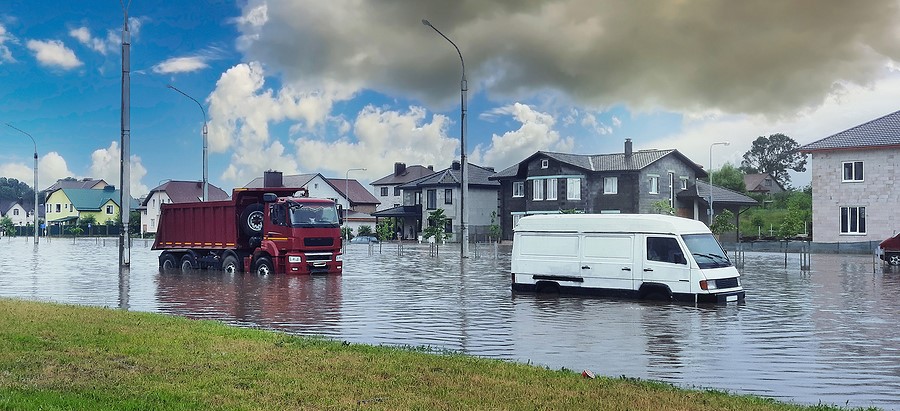News
The Problem With Surface Water Flooding
With the pressures of climate change being felt increasingly around the world as time goes on, it’s expected that we will start to see more frequent extreme weather events in the near future, everything from droughts and soaring temperatures to record-breaking rainfall and flooding.
Where the latter is concerned, analysis shows that climate change is now increasing the chances of heavy or intense rainfall across many parts of the UK, especially during winter, which is resulting in higher risks of both river and surface water flooding.
There are various factors involved in the risk of such flooding events, such as the permeability of the ground. River flooding is more likely to take place if water makes its way into water courses instead of being absorbed by the ground.
If the ground is less permeable and steep, more water will enter streams and rivers. More surface water runoff will also be seen if the ground has been saturated by previous rainfall or baked by the hot sun.
Surface water flooding takes place when rainfall doesn’t soak into the ground or doesn’t run off into drainage systems.
The risks here depend on the permeability of the ground and the capacity of drainage systems, and it is often seen in urban environments where impermeable surfaces like tarmac and concrete are in abundance, and where drainage systems can often be overwhelmed.
In 2019, the UK Climate Change Committee issued a warning that 1.4 million people in England now face a risk of 1:75 or greater of flooding of any kind, with the current associated damages to homes costing £279 million annually.
Where surface water flooding in particular is concerned, figures show that around 3.2 million properties in England are now at risk – and this is a shared problem that will require collaborative efforts between the government, businesses and individuals alike to address.
As Sir James Bevan, chief executive of the Environment Agency, explained in 2018 at the CIWEM Surface Water Management Conference, surface water flooding is actually the biggest flood risk of them all, yet many people may not know that they could be affected – which means they’ll be less prepared or able to cope with the effects when they materialise.
He went on to say that this kind of flooding is also a risk that typically hits those communities that are less able to afford it, with urban areas more vulnerable because they have more concrete. Poorer urban areas that have high density housing are the most vulnerable of them all, with paved drives and parking spaces not absorbing the rainwater.
So what are the solutions to surface water flooding?
There are numerous ways in which the risks associated with flooding are being mitigated around the country. Increasing resilience against flooding is key and investments are now being made in improving flood defences near rivers – and developing more of them. Natural flood management work is also being undertaken to restore bends in rivers and change how land is managed to ensure that the soil is able to absorb more water, among other projects.
Where surface water flooding in particular is concerned, a map of areas facing higher risks was produced in 2008. And in 2013, the Risk of Flooding from Surface Water maps were produced. It is also possible to check the risk to property online. Improvements have been made in forecasting flooding and the flood warning service has been completely overhauled.
Schemes to reduce surface water flood risks are also underway, such as the recently completed £14 million Willerby and Derringham Flood Alleviation Scheme that was led by East Riding of Yorkshire Council and Hull City Council.
This project provided around 200 businesses and 8,000 homes with greater protection from surface water flooding through a number of lagoons used to store rainwater. Resembling flat pasture, these lagoons are dry for the majority of the time and are only filled during heavy and intense rainfall.
What about SuDS?
As we have explained, rain in natural environments falls on permeable surfaces and is absorbed by the ground, in a process known as infiltration. But in built-up and urban areas, many of these once-permeable surfaces have been sealed by paving, tarmac and buildings, all of which limit natural infiltration.
The ensuing problem is that surface water runoff makes its way into the sewer networks, which can lead to flooding downstream and deterioration of water quality in rivers, with sewers finding themselves overwhelmed by the amount of water they have to deal with, so dirty excess water is then discharged into watercourses.
One solution to this problem is sustainable drainage systems (SuDS for short), which provide an alternative option for surface water runoff, reducing flooding risks, improving water quality and enhancing local biodiversity.
They work by mimicking natural drainage systems, with the overall aim being to factor in long-term social and environmental factors when considering drainage, and striving to ensure that surface water is a resource that is managed properly for maximum benefit.
SuDS now form a key part of any and all robust flood risk management plans for new developments, taking into account water quantity, water quality, biodiversity and amenity.
They usually manage rainfall close to where it falls and they can be designed to transport surface water elsewhere, to slow runoff down before it goes into waterways, to store water in natural contours and to allow it to soak into the ground, evaporate or be transpired from vegetation.
There are all sorts of benefits associated with SuDS, including flood risk reduction, pollution prevention, improvements to amenity and biodiversity, supporting urban growth and rainwater harvesting for reuse purposes. They also reduce peak flows to treatment works.
Do you want to find out more about business water saving strategies? Get in touch with H2o Building Services today.
